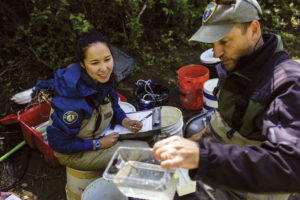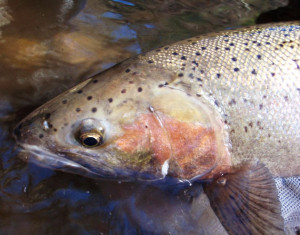In late December 2005, the National Marine Fisheries Service (NMFS) reaffirmed the threatened status of Central California Coast steelhead trout (Oncorhynchus mykiss), including steelhead in Bay Area streams. NMFS added that the Central Coast steelhead population—first listed as threatened under the Endangered Species Act in 1997—is “likely to become endangered within the foreseeable future.”
- Courtesy USFWS-Bob Hines, www.fws.gov
A recent landmark study of Bay Area steelhead runs makes it clear that a lot is at stake for the species. “The fact that we still have steelhead in our urbanized streams is a tribute to their hardiness. [But] if we want to keep them here, we need to identify and protect minimum flows required for their survival,” says Gordon S. Becker, senior scientist at the Center for Ecosystem Management and Restoration (CEMAR), the nonprofit that published the report last fall.
Until last year, there hadn’t been a comprehensive analysis of the historical status and current distribution of steelhead and nonanadromous, or resident, rainbow trout in San Francisco Estuary tributaries. Based on historical documents and fish surveys conducted over six years, CEMAR found that of the 277 streams surveyed, 58 percent of those once supporting steelhead no longer do.
Steelhead trout start their lives in fresh water, go to sea, and then return to their natal streams to reproduce, while rainbow trout are the same species but do not leave fresh water—because of either manmade or natural obstacles. During the spawning season from January through April, female steelhead build redds (gravel nests) at the top of a riffle and lay their eggs. The young fry stay in the stream for several years before heading out to sea, where they bulk up for three years and turn silvery like salmon before returning to spawn. Unlike coho salmon, which die after spawning, steelhead return to the sea and live to spawn another day.
“We found steelhead in many more streams than expected, which proves that they are persistent and hearty,” says Becker. Further, many streams that no longer support true steelhead do still have rainbow trout. “That is important in light of the recent NMFS ruling.”
That’s because NMFS, while reaffirming steelhead’s ESA status, excluded resident rainbow and landlocked trout. “All forms of steelhead [and rainbows] in the Bay Area and the Central Coast should be protected,” says Jeff Miller of the Alameda Creek Alliance, which has been working for a decade to restore steelhead populations to Alameda Creek, the second-largest watershed feeding the Bay. Thought to be descendants of the watershed’s wild fish, “resident and landlocked rainbow trout represent the best native gene pool for restoring steelhead,” Miller says.
Though native to western North America, rainbows born in hatcheries live in streams from California to Colorado to Scotland. Ironically, this widely introduced fish is listed in the Global Invasive Species Database as one of the world’s 100 worst invaders due to its negative effects on native fish populations outside its own natural range.





